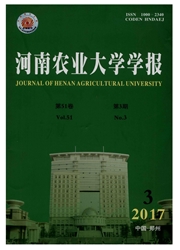

 中文摘要:
中文摘要:
为了解河南省小麦纹枯病菌对氟环唑及烯唑醇的敏感性,采用菌丝生长速率法测定了2种杀菌剂对从河南省15个地市分离的98株病菌的毒力。结果表明,供试菌株对氟环唑和烯唑醇的EC50值分别分布为0.027 1~0.225 7 mg·L^-1和0.033 8~0.346 3 mg·L^-1。敏感性频率分布显示,小麦纹枯病菌群体中存在着对烯唑醇不敏感的亚群体,而对氟环唑则不存在。将其中呈连续单峰频次分布的大多数菌株群体的平均EC50值(0.087 7±0.048 0)mg·L^-1和(0.063 6±0.023 6)mg·L^-1分别作为病菌对氟环唑和烯唑醇的敏感性基线,氟环唑的平均EC50是烯唑醇的1.38倍,表明病菌对烯唑醇更为敏感。小麦纹枯病菌对2种杀菌剂的敏感性与菌株的地理来源无明显相关性;小麦纹枯病菌对氟环唑与烯唑醇的敏感性与其他9种杀菌剂间存在着一定程度的相关性。
 英文摘要:
英文摘要:
The sensitivities of Rhizoctonia cerealis to epoxiconazole and diniconazole were determined by measuring the mycelial growth on the fungicide-amended media using 98 isolates collected from 15 cities of Henan province. The results indicated that 50% effective concentration( EC50) values of all isolates to epoxiconazole and diniconazole ranged from 0. 027 1 to 0. 225 7 mg ·L^-1 and 0. 033 8 to0. 346 3 mg· L^-1,respectively. The results of the frequency analysis revealed that subpopulation,which was less sensitive to diniconazole,had been discovered in the tested isolates. However,most of the isolates were sensitive to epoxiconazole. The mean EC50 values of( 0. 087 7 ± 0. 048 0) mg·L^-1and( 0. 063 6 ± 0. 023 6) mg·L^-1for most isolates showed a unimodal curve distribution,which was treated as the sensitivity baseline of R. cerealis to epoxiconazole and diniconazole respectively. The mean EC50 value of epoxiconazole was 1. 38 times that of diniconazole,which meant that R. cerealis was more sensitive to diniconazole. The isolates collected from different regions demonstrated different sensitivities. Especially,there was correlation to some extent between epoxiconazole and diniconazole with other nine fungicides.
 同期刊论文项目
同期刊论文项目
 同项目期刊论文
同项目期刊论文
 期刊信息
期刊信息
